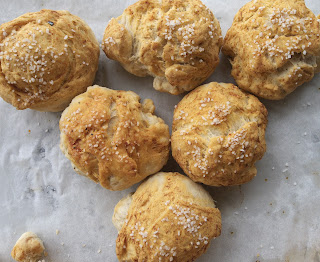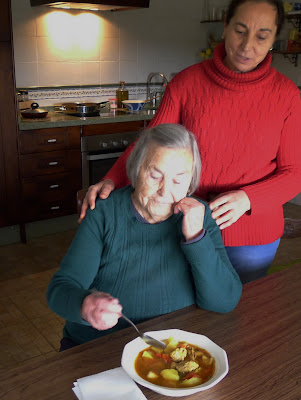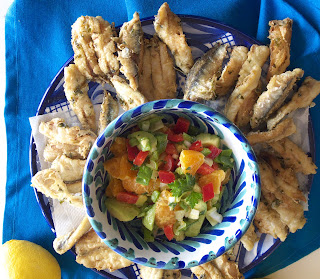 |
| Beefed-up chicken burgers on sesame mollete buns. |
In our weekly newspaper I noticed that a local burger joint had competed in the second annual Spanish hamburger championships. A burger competition? Since when are burgers a thing?
Maybe since Chef Dani García got into the burger act. I first tried his Burger Bull, a burger of rabo de toro (bull's tail) meat on a bun way back in 2010, when Chef Dani had a trendy tapas joint in Málaga. He has since risen to three-star fame at Calima in Marbella, after which he walked away from the high-end restaurant business. He first collaborated with McDonald’s España back in 2015 to create a “gourmet burger”. He’s got a new “signature” burger for McDonald’s, the Bearnesa, with a chimichurri twist on classic Bearnaise sauce, topping a patty of Spanish beef. (One critic commented that it tasted just like a McDonald’s hamburger.) Chef García’s new restaurant in New York, Casa Dani, doesn’t list burgers on the menu. But, leading the tapas is “oxtail brioche,” essentially the same Burger Bull from his original Málaga establishments.
But, back to the championships. The winner was Junk Burger from Madrid, with a patty of vaca rubia gallega, aged cow meat of the Galician Rubia breed, with Cheddar and locally-smoked bacon. Scrolling through the other entries, I surmised that the quality of the meat plus a knock-out sauce were the main criteria. Rubia Gallega and Black Angus seemed the preferred beef. Bacon and Cheddar were frequent accompaniments, although one entry had strips of grilled steak wrapped around the ground beef patty and payoyo goat cheese instead of Cheddar. Some had house-made brioche buns, including one entry colored carmine with beets.
“Ageing” is relatively new for beef in Spain. Beef used to be yearling beef, ternera or añojo, butchered and sold fresh. That is changing, with superb vacuno and buey available. “Old cow” meat, butchered at five to 10 years, is especially esteemed. Aged up to 40 days, it packs huge beef flavor. Well-marbled flesh makes for juicy meat. That’s what makes prize-winning hamburgers.
I’m making chicken burgers with an Asian inflection and trying my hand with Dani García’s Burger Bull. A couple of knock-out sauces are based on prepared mayonnaise.
 |
| Miso paste punches up the umami when mixed with ground chicken thighs for this burger. |
 |
| Melted cheese tops a burger of chopped, braised oxtail. |
Beefed-Up Chicken Burgers
Burguer de Pollo
I actually prefer chicken burgers to beef. I’m beefing up the flavor with the addition of umami-packing miso paste (made from fermented soybeans) and adding juiciness with ibérico pork tocino (fat). The mayonnaise with soy sauce is a good accompaniment. If I were making fries, they would be sweet potato fries.
Makes 2 burgers.
9 ounces boneless chicken thigh meat, ground
1 tablespoon olive oil
¼ cup finely chopped tocino or bacon (1 ounce)
3 tablespoons finely chopped red onion
1 teaspoon miso paste
¼ teaspoon pimentón de la Vera (smoked paprika)
Freshly ground black pepper
2 sesame buns, split and toasted
Teriyaki Mayonnaise (recipe follows)
Sliced tomatoes
Thinly sliced red onion
Heat the oil in a small skillet with the chopped tocino until tocino releases its fat. Sauté the chopped onion on medium heat until softened, but not browned, 4 minutes. Remove the skillet from the heat and stir in the miso and pimentón. Allow to cool.
 |
| Soy-flavored mayonnaise on the burger. |
Combine the mixture from the skillet with the ground chicken. Season with pepper. Mix well. Allow to stand 15 minutes, then shape into two burger patties.
Heat skillet on moderately high heat and brush with oil. Sear the burgers, about 2 minutes per side. Lower heat and cover the skillet and cook 2 minutes more.
Spread the buns with mayonnaise. Top with burgers, tomatoes and onion.
Teriyaki Mayonnaise
Mayonesa de Teriyaki
For 2-3 sandwiches.
2 tablespoons mayonnaise
1 teaspoon soy sauce
½ teaspoon honey
1 teaspoon PX vinegar (or balsamic)
¼ teaspoon sesame oil
Stir the mayonnaise until smooth. Whisk in the soy, honey, vinegar and oil.
Molletes are a type of round or oblong soft bun popular in Andalusian bakeries. They’re perfect for grilled sandwiches (see campero grilled sandwich). Typically, molletes are big, about 6 inches in diameter, but many panaderías make smaller ones, a perfect size for burgers.
6 (3 ½-inch) molletes
1 egg yolk
1 teaspoon water
Sesame seed
Heat broiler to 475ºF.
Place molletes on a sheet pan. Stir the yolk with water. Brush the tops and sides of the molletes with the egg. Sprinkle with sesame.
Grill the buns under the broiler just until the tops are browned, 2-3 minutes.
Oxtail Burgers
Burguer Bull
Braised rabo de toro, or bull’s tail, is a specialty in Sevilla and Córdoba, where some butchers sell carne de lidia, meat from a toro bravo, after a bullfight. Of course, it doesn’t have to be the tail of a fighting bull. Butcher’s oxtail is just fine.
In this recipe, the braised meat is removed from the bones, then finely chopped and mixed with some of the gelatin-rich cooking liquid so that, with chilling, it solidifies. I didn’t add enough of the liquid, so the result was more like “sloppy José’s” than burgers! I’ve got more of the chopped oxtail. I’ll serve it with the rich gravy on some mashed potatoes instead of buns.
Make the braised oxtail a day before preparing the burgers, so the chopped meat has time to chill.
1 oxtail (approx. 2 ¾ pounds), cut crosswise
Salt
Freshly ground black pepper
1 teaspoon pimentón de la Vera (smoked paprika)
1 teaspoon oregano
Sunflower oil for searing the meat
2 tablespoons olive oil
1 cup chopped onion
1 cup diced carrot
3 cloves garlic, lightly crushed
1 cup grated tomato pulp
¼ cup brandy
2 cups red wine
4 cups water or beef stock
Strip of orange zest
1 bay leaf
Sprig of thyme
1 clove garlic, peeled
3 tablespoons olive oil
1 cup finely chopped shallots (about 6 shallots)
1 cup chopped mushrooms (2 ½ ounces)
Sliced cheese (such as Manchego or Havarti)
Mini burger buns
Burger Bull Sauce (recipe follows)
Rucula
Season the pieces of oxtail with salt, pepper, pimentón and oregano. Allow to stand for 30 minutes.
Heat a heavy skillet and brush it with sunflower oil. Sear the pieces of oxtail. Remove them when browned on all sides. Reduce heat to moderate and add the olive oil. Sauté the onion, carrot and garlic until onions begin to brown, 5 minutes. Add the tomato pulp and cook 5 minutes more. Return the pieces of oxtail to the pan.
 |
| Braised oxtail. |
Pour the brandy over the meat. Either flambé the brandy or cook on high heat until the alcohol is cooked off. Add the wine and reduce it slightly. Add the water or stock, zest, bay and thyme. Cover and cook the oxtail, turning the pieces occasionally, until the meat is fork tender, about 2 ½ hours. (The braised oxtails are ready to eat at this point, should you not wish to use the meat for burgers.)
 |
| Chop oxtail for burgers. |
Lift the pieces of oxtail out of the pan. When they are cool enough to handle, strip the meat off the bones. Discard excess fat, gristle and the bones. Put the pieces of meat on a cutting board and chop them as finely as possible (or chop in a food processor).
Pour all the remaining liquid in the pan through a sieve. Save some of the diced carrots to add to the burger mix. Discard the remaining solids. Place the strained liquid (about 4 cups) in a saucepan with the clove of peeled garlic and bring to a boil. Reduce heat and let it bubble, uncovered, until reduced by half. Skim out the cooked garlic and save it for the mayonnaise. Reserve the oxtail reduction.
Heat the 3 tablespoons of oil in a small skillet and sauté the shallots on low heat until they are browned and caramelized, 5 minutes. Remove them and drain excess oil.
Add oil back to the skillet and sauté the mushrooms until lightly browned.
Combine the mushrooms and shallots in a mixing bowl with the chopped oxtail meat and a few pieces of diced cooked carrot. Add ¼ cup of the reserved oxtail reduction liquid. Combine very well. Taste and season with additional salt and pepper.
 |
| Press chopped meat into a roll and chill. |
Shape the meat mixture into a roll 3 inches in diameter. Wrap it tightly in plastic film. Refrigerate at least 8 hours.
When ready to cook the burgers, use a serrated knife to cut 1 ½-inch-thick slices from the meat roll. Sear them on one side in a skillet or plancha. Turn the burgers, top with a slice of cheese, lower heat and cover the pan until cheese melts.
Place the burgers on toasted buns that have been spread with Burger Bull Sauce. Top with arugula.
Burger Bull Sauce
Salsa Burguer Bull
The trademarked sauce by Dani García is made with sunflower oil, pasteurized eggs and beef extract. My version starts with mayonnaise from a jar. The addition of the reduced oxtail cooking liquid adds gelatin that thickens the mayonnaise further. Use the clove of garlic that cooked in the reduction of the oxtail cooking liquid.
1 cup prepared mayonnaise
1 clove cooked garlic
½ teaspoon Dijon mustard
3 tablespoons oxtail reduction
1 teaspoon Sherry vinegar
Few drops of Tabasco or other pepper sauce
In a blender combine the mayonnaise, garlic, mustard, oxtail reduction, vinegar and Tabasco. Blend to make a smooth sauce. Add additional vinegar or Tabasco to taste.
More variations on the burger theme:










































